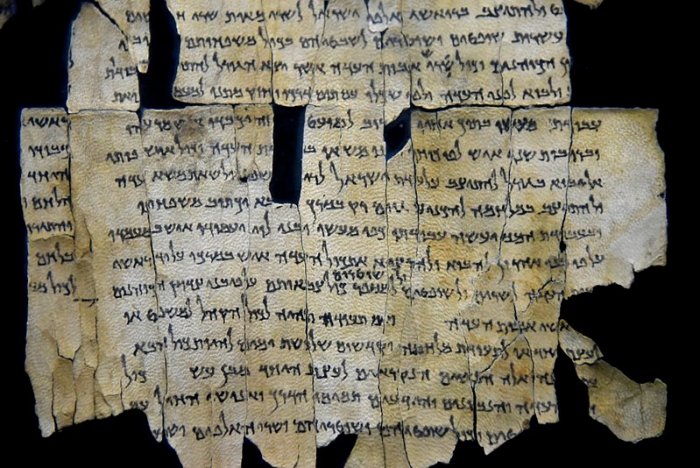Jan Bartek – AncientPages.com - Scandal is perhaps not the best word to describe this news, but it’s certainly embarrassing and disappointing.
What some suspected for a while has now been confirmed. The Washington, D.C. Museum has confirmed that 16 Dead Sea scrolls fragments kept in the Museum of the Bible are forgeries.
Part of Dead Sea Scroll number 28a (1Q28a) from Qumran Cave 1. Credit: Osama Shukir Muhammed Amin FRCP(Glasg), CC BY-SA 4.0
In 2018, German researchers conducted a series of tests. The results revealed five of the 16 Dead Sea Scrolls fragments in the collection of the Washington-based Museum of the Bible, are fakes.
Unfortunately, the number of forgeries has risen. Independent researchers funded by the Museum of the Bible, have now announced that “all 16 of the museum’s Dead Sea Scroll fragments are modern forgeries that duped outside collectors, the museum’s founder, and some of the world’s leading biblical scholars. Officials unveiled the findings at an academic conference hosted by the museum, “National Geographic reports.
“The Museum of the Bible is trying to be as transparent as possible,” says CEO Harry Hargrave. “We’re victims—we’re victims of misrepresentation, we’re victims of fraud.”
Aerial view of Qumran Caves Photo: Duby Tal, Albatross
In a report spanning more than 200 pages, a team of researchers led by art fraud investigator Colette Loll found that while the pieces are probably made of ancient leather, they were inked in modern times and modified to resemble real Dead Sea Scrolls. “These fragments were manipulated with the intent to deceive,” Loll says.
This truly disappointing news should not overshadow the fact that there are many more Dead Sea scrolls fragments and they are most likely and hopefully authentic.
The Dead Sea scrolls were discovered in West Jordan in 1947, near the ruins of Qumran.
As previously mentioned in Ancient Pages, “clay pots filled with ancient scrolls were found stored in eleven caves, located 13 miles east of Jerusalem, Israel.
The texts are written using a carbon-based ink and are mostly in Hebrew, with some in Aramaic (a Semitic language allegedly spoken by Jesus) and in Greek.
Preliminary analysis showed the texts belonged to the Essenes, members of a religious sect or brotherhood that flourished in Palestine from about the 2nd century BC to the end of the 1st century AD.
However, a later review of these results has raised additional questions related to the scrolls, considered one of the greatest archaeological events of the twentieth century.”
See also:
Hidden Text Discovered On Dead Sea Scrolls Reveals An Unknown Manuscript Is Still Missing
Israeli-German Researchers Will Digitize Dead Sea Scrolls
2,000-Year-Old Herculaneum Scrolls Will Be Unwrapped And Deciphered
As years passed, scientists learned more about the Jewish world in which Jesus lived. Knowledge gained from the Dead Sea scrolls helped to understand why his message drew followers and opponents.
The scrolls contain a large variety of writings: fragments of every book of the Old Testament (except the Book of Esther), rules for religious rituals, texts on the preparation of the Qumran sect for war at the End of Time, calendars, horoscopes and much more, but there is still plenty we don’t know about these precious ancient texts.
Some years ago, archaeologists discovered 30 ancient skeletons that may one day in the future unravel the secrets of the Dead Sea Scrolls. Found in the same site in Qumran, the skeletons are about 2,000-year-old and scientists hope these bodies can help to uncover who wrote or protected the ancient manuscripts. The authors of the Dead Sea Scrolls are still unknown.
Content of the Dead Sea scrolls have sometimes been surprising, but also intriguing. Utilizing 60 minuscule fragments of mysterious ancient code from the second-to-last unpublished Dead Sea Scrolls, researchers have decoded a unique 364-day calendar once used by the enigmatic Qumran Sect in the Judean Desert.
See also: More Archaeology News
This particular scroll was written in coded Hebrew, a rarity among the existing body of deciphered texts.
Researchers also discovered the Dead Sea scrolls contain two events not mentioned in the Bible.
In addition to this, scientists also deciphered parts of the scrolls and learned Noah’s Ark was pyramid-shaped.
The Dead Sea scrolls remain valuable ancient Jewish religious manuscripts that are of great historical, religious, and linguistic significance. Many thousands of written fragments have been discovered in the Dead Sea area.
It is undoubtedly frustrating to learn that the Museum of the Bible has been in possession of faked Deas Sea scrolls, but this news should not discourage people interested in ancient history to learn more about the Deas Sea scrolls.
Written by Jan Bartek - AncientPages.com Staff Writer







